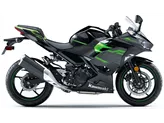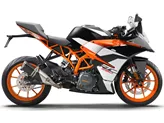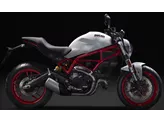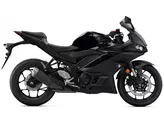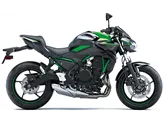Kawasaki Ninja 400 2018 vs. Kawasaki Z650 2017

Kawasaki Ninja 400 2018

Kawasaki Z650 2017
Visão geral - Kawasaki Ninja 400 2018 vs Kawasaki Z650 2017
The Kawasaki Ninja 400 2018 and the Kawasaki Z650 2017 are both popular models from Kawasaki, but they have some key differences.
Starting with the technical specifications, the Ninja 400 has a smaller engine displacement of 399cc compared to the Z650's 649cc. This results in a difference in power output, with the Ninja 400 producing 45 HP and the Z650 producing 68.2 HP. The Ninja 400 also has a lower torque of 38 Nm compared to the Z650's 65.7 Nm.
In terms of the chassis, both bikes have a steel frame and a tubular type frame. However, the Ninja 400 has a rake angle of 63 degrees and a trail of 93 mm, while the Z650 has a rake angle of 65.5 degrees and a trail of 100 mm. This means that the Z650 has a slightly sportier chassis compared to the Ninja 400.

Kawasaki Ninja 400 2018
Both bikes have a telescopic front suspension and a monoshock rear suspension with pre-load adjustment. The Ninja 400 has a front fork diameter of 41 mm, while the Z650 has a front fork diameter of 41 mm as well.
In terms of braking, the Ninja 400 has a single disc front brake with a diameter of 310 mm and a dual-piston caliper, while the Z650 has a dual disc front brake with a diameter of 300 mm and a dual-piston caliper. Both bikes have ABS as a standard feature.
In terms of dimensions, the Ninja 400 has a narrower front tire width of 110 mm compared to the Z650's 120 mm. The Ninja 400 also has a smaller fuel tank capacity of 14 liters compared to the Z650's 15 liters.

Kawasaki Z650 2017
Now let's discuss the strengths and weaknesses of each bike. The Ninja 400 has a chassis that is suitable for sporty riding, a lightweight design that allows for effortless handling, and a smooth engine response. It also has a relaxed seating position that increases confidence and LED headlights for improved visibility. However, it has non-adjustable brake and clutch levers and high wind noise with the stock windshield for riders over 180 cm tall.
On the other hand, the Z650 has a more powerful and uniform power delivery, a sporty chassis, and compact dimensions. It also has a negative display for improved visibility. However, it may be a bit small for taller riders.
In conclusion, the Kawasaki Ninja 400 2018 and the Kawasaki Z650 2017 have their own strengths and weaknesses. The Ninja 400 is a great option for riders looking for a lightweight and agile bike with a smooth engine response, while the Z650 offers more power and a sportier chassis. Ultimately, the choice between the two will depend on the rider's preferences and intended use.
Especificações técnicas Kawasaki Ninja 400 2018 em comparação com Kawasaki Z650 2017
Prós e contras em comparação
Prós e contras em comparação
Kawasaki Ninja 400 2018

Em resumo, a Ninja 400 pode ser descrita como a entrada perfeita no mundo das superdesportivas. Não é possível obter mais potência com a A2, o aspeto sugere muito mais potência, o veículo é divertido de conduzir, é indulgente em todos os aspectos e ainda permite um estilo de condução verdadeiramente desportivo. Aqueles que tinham preocupações legítimas sobre a falta de potência nas várias máquinas de 250 cúbicos agora não têm mais desculpas. Ninja 400, é bom ter-te connosco!
Kawasaki Z650 2017

A Kawasaki Z 650 é a ponta da classe média para os pequenos condutores masculinos e femininos. Com as suas dimensões compactas, provavelmente não se sentirá confortável como um gigante. No entanto, as sensações reconfortantes vêm do motor, que se delicia com uma tração muito suave. Do lado do chassis, foi escolhida uma configuração apertada típica da Kawasaki, que encontra um ótimo compromisso na utilização diária. O ecrã negativo é muito fácil de ler e faz lembrar a sua antecessora, a ER-6n - muito bonito!
Comparação de preços Preço médio de mercado Kawasaki Ninja 400 vs Kawasaki Z650
There are a few key differences between a Kawasaki Ninja 400 2018 and a Kawasaki Z650 2017. In terms of price, the actual average price of a Kawasaki Z650 2017 is about 5% higher. A Kawasaki Ninja 400 2018 experiences a loss of 160 EUR in one year and 230 EUR in two years of ownership. This is offset by a loss of 420 EUR and 640 EUR for a Kawasaki Z650 2017. Compared to Kawasaki Z650 2017 there are less Kawasaki Ninja 400 2018 bikes available on the 1000PS.de Marketplace, specifically 10 compared to 11. It takes less time to sell a Kawasaki Z650 with 76 days compared to 105 days for the Kawasaki Ninja 400. Since model year 2018 1000PS.de editors have written 9 reviews for the Kawasaki Ninja 400 and 31 reviews for the Kawasaki Z650 since model year 2017. The first review for the Kawasaki Ninja 400 was published on 22/11/2017 and now has more than 44 300 views. This compares to more than 25 000 views for the first review on Kawasaki Z650 published on 08/11/2016.


